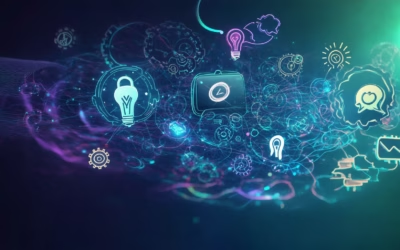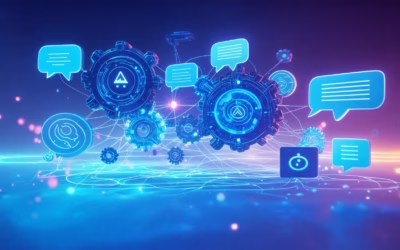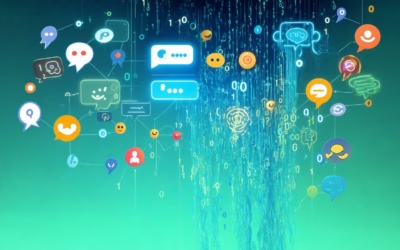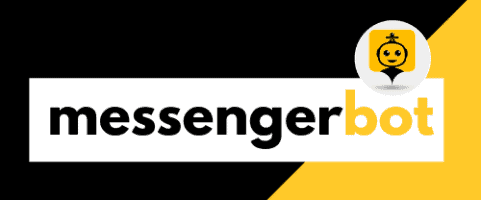As the world increasingly embraces the power of artificial intelligence (AI), the demand for skilled chatbot developers has skyrocketed. These innovative professionals are at the forefront of creating conversational interfaces that revolutionize how we interact with technology. Whether you’re a tech-savvy individual seeking a lucrative career path or a business owner aiming to enhance customer engagement, becoming an AI chatbot developer offers boundless opportunities. This comprehensive guide will unveil the secrets to mastering this cutting-edge field, equipping you with the knowledge and skills to design intelligent chatbots that seamlessly integrate into diverse platforms and industries. From understanding the fundamental concepts to exploring advanced techniques, this article will be your ultimate companion on the journey to becoming an AI chatbot developer.
How to become an AI chatbot developer?
Subsection 1: Chatbot Developer salary
Becoming an AI chatbot developer is a rewarding career path that combines programming skills, machine learning expertise, and a deep understanding of natural language processing (NLP) techniques. To embark on this journey, you’ll need a solid foundation in computer science, programming languages, and machine learning techniques. Here are the key steps:
- Master programming languages like Python, Java, or C++, as these are commonly used for developing chatbots and natural language processing (NLP) models.
- Gain proficiency in NLP techniques such as text preprocessing, tokenization, stemming, lemmatization, and named entity recognition. Understand algorithms like Naive Bayes, decision trees, and neural networks for text classification and sentiment analysis.
- Study machine learning frameworks and libraries like TensorFlow, PyTorch, scikit-learn, and NLTK. These tools provide pre-built models and functions for developing chatbots and NLP applications.
- Explore chatbot development platforms and frameworks like Dialogflow, Amazon Lex, Microsoft Bot Framework, and Rasa. These platforms offer tools and APIs for building, training, and deploying chatbots.
- Develop expertise in conversational design, user experience (UX), and dialogue management. Understand how to create natural and engaging conversations, handle context, and manage conversational flows.
- Build practical experience by creating chatbots for various domains, such as customer service, e-commerce, healthcare, or education. Participate in hackathons, open-source projects, or internships to gain hands-on experience.
- Stay updated with the latest advancements in AI, NLP, and chatbot technologies by reading research papers, attending conferences, and participating in online communities and forums.
- Consider pursuing certifications or online courses from reputable institutions or technology companies like Coursera’s AI Engineer Professional Certificate or Udacity’s AI for Trading Nanodegree to validate your skills and knowledge.
By following these steps, combining theoretical knowledge with practical experience, and continuously learning and adapting to new technologies, you can become a proficient AI chatbot developer and unlock a world of exciting opportunities in this rapidly growing field.
Subsection 2: Ai chatbot developer jobs
As the demand for AI-powered chatbots continues to soar, the job market for AI chatbot developers is thriving. Companies across various industries, from e-commerce and finance to healthcare and customer service, are actively seeking skilled professionals to design, develop, and implement intelligent conversational agents.
Some of the popular job titles in this domain include:
- Chatbot Developer: Responsible for building, training, and deploying chatbots using various NLP techniques and machine learning models.
- Conversational AI Engineer: Focuses on developing and integrating conversational AI systems, including chatbots and virtual assistants, into applications and platforms.
- NLP Engineer: Specializes in natural language processing, developing algorithms and models for text analysis, language understanding, and generation.
- Dialogue Systems Developer: Designs and implements dialogue management systems, ensuring smooth and natural conversational flows for chatbots.
- AI Software Engineer: Develops AI-powered software solutions, including chatbots, using various programming languages and frameworks.
Companies like Amazon, Google, Microsoft, IBM, Apple, and Brain Pod AI are among the leaders in the AI and chatbot development space, offering numerous opportunities for skilled professionals.
To stay competitive in the job market, it’s essential to continuously upskill and stay updated with the latest advancements in AI, NLP, and chatbot technologies. Additionally, building a strong portfolio of chatbot projects and actively participating in online communities and hackathons can significantly enhance your chances of landing your dream job as an AI chatbot developer.

What does a chatbot developer do?
As an AI chatbot developer, my role involves designing, building, and deploying intelligent conversational applications capable of engaging in natural language interactions with users. My primary responsibilities encompass defining the chatbot’s purpose, functionalities, and conversational flows to align with user needs and Brain Pod AI’s business objectives.
A crucial aspect of my work is designing the chatbot’s architecture and seamlessly integrating it with backend systems, databases, and APIs to access relevant information. This ensures a smooth flow of data exchange, enabling the chatbot to provide accurate and contextual responses.
Implementing natural language processing (NLP) algorithms is a core component of my role. These algorithms allow the chatbot to interpret user inputs accurately and generate contextually appropriate responses, fostering a natural and engaging conversational experience. To achieve this, I leverage advanced machine learning models, dialogue management systems, and knowledge bases.
Continuous improvement is key to delivering an exceptional user experience. I analyze user interactions, feedback, and engagement metrics to identify areas for optimization and enhance the chatbot’s performance. This iterative process ensures that the chatbot remains up-to-date, intelligent, and responsive to users’ evolving needs.
Ensuring the chatbot adheres to data privacy, security, and ethical AI principles is a top priority. I work closely with cross-functional teams, including product managers, designers, and subject matter experts, to develop chatbots that prioritize user trust and transparency while delivering an optimal user experience.
To excel in this role, I possess strong programming skills (Python, Java, C++), expertise in NLP, machine learning, and conversational AI technologies. Excellent problem-solving, communication, and project management abilities are essential to navigate complex challenges and collaborate effectively with diverse teams. Staying updated with the latest advancements in AI and conversational technologies is crucial for creating cutting-edge chatbot solutions that provide seamless and intelligent user experiences.
AI chatbot developer skills
As an AI chatbot developer, I possess a diverse set of skills to design, build, and deploy intelligent conversational applications. Some of the key skills required for this role include:
- Programming Languages: Proficiency in programming languages such as Python, Java, C++, and JavaScript is essential for developing chatbot applications and integrating them with various systems and APIs.
- Natural Language Processing (NLP): In-depth knowledge of NLP techniques, including text preprocessing, tokenization, part-of-speech tagging, named entity recognition, and sentiment analysis, is crucial for building chatbots that can understand and generate human-like responses.
- Machine Learning and Artificial Intelligence: Expertise in machine learning algorithms, deep learning models (e.g., recurrent neural networks, transformers), and AI technologies like reinforcement learning and knowledge representation is necessary for creating intelligent and adaptive chatbots.
- Conversational Design: The ability to design and implement effective conversational flows, dialogue management systems, and context-aware interactions is vital for delivering a natural and engaging user experience.
- Data Analysis and Visualization: Skills in data analysis, data mining, and data visualization are essential for interpreting user interactions, identifying patterns, and optimizing the chatbot’s performance based on insights derived from data.
- Cloud Computing and DevOps: Knowledge of cloud computing platforms (e.g., AWS, Google Cloud, Microsoft Azure) and DevOps practices is valuable for deploying and managing chatbot applications in a scalable and efficient manner.
- Collaboration and Communication: Strong collaboration and communication skills are crucial for working effectively with cross-functional teams, such as product managers, designers, and subject matter experts, to align on requirements and deliver optimal user experiences.
Additionally, staying up-to-date with the latest advancements in AI, NLP, and conversational technologies is essential for creating innovative and cutting-edge chatbot solutions that provide seamless and intelligent user experiences.
AI chatbot developer certification
While there are no universally recognized certifications specifically for AI chatbot developers, several certifications can demonstrate expertise in relevant areas such as natural language processing (NLP), machine learning, and conversational AI. Here are some notable certifications that can be valuable for AI chatbot developers:
- Microsoft Certified: Azure AI Engineer Associate: This certification from Microsoft validates skills in designing and implementing AI solutions using Azure AI services, including natural language processing, computer vision, and conversational AI.
- AWS Certified Machine Learning – Specialty: Offered by Amazon Web Services (AWS), this certification validates expertise in building, deploying, and managing machine learning solutions on the AWS platform, which can be applicable to chatbot development.
- Google Cloud Professional Data Engineer Certification: This certification from Google Cloud Platform (GCP) focuses on designing and building data processing systems, including those involving natural language processing and machine learning, which are essential for chatbot development.
- TensorFlow Developer Certificate: Provided by the TensorFlow team at Google, this certification validates proficiency in using TensorFlow, a popular open-source machine learning framework, for building and deploying AI models, including those used in chatbots.
- Certified Conversational Design Professional: Offered by the Conversation Design Institute, this certification focuses on the principles and best practices of conversational design, which is crucial for creating effective and engaging chatbot interactions.
- IBM Watson AI and Data Certification: IBM offers various certifications related to their Watson AI and data services, including certifications for natural language processing, machine learning, and conversational AI, which are relevant for chatbot development.
While certifications can demonstrate expertise and commitment to the field, practical experience in building and deploying chatbots, along with a strong portfolio of projects, is often equally or more valuable to potential employers or clients. Additionally, staying up-to-date with the latest advancements in AI, NLP, and conversational technologies through continuous learning and professional development is essential for AI chatbot developers.
How Much Do Chatbot Developers Make?
As an AI chatbot developer, my role is to provide you with accurate and up-to-date information on the earning potential in this field. The salaries of chatbot developers can vary significantly based on several factors, such as experience, location, industry, and company size.
According to PayScale, the average annual salary for a chatbot developer in the United States is around $89,000. However, it’s important to note that this figure can fluctuate. Entry-level chatbot developers may earn around $60,000 to $70,000, while highly experienced professionals can command upwards of $120,000 or more.
Location plays a significant role in determining salaries. In tech hubs like the San Francisco Bay Area, chatbot developers can expect higher salaries, with average annual earnings ranging from $100,000 to $150,000, according to Glassdoor. Conversely, in regions with lower costs of living, salaries may be lower but still competitive within the local job market.
In addition to base salaries, chatbot developers may also receive additional compensation, such as bonuses, stock options, and comprehensive benefits packages. Industries with a high demand for chatbot solutions, like e-commerce, healthcare, and finance, often offer higher remuneration to attract top talent.
Chatbot Developer Salary
Chatbot developers’ salaries can vary significantly based on factors such as experience, location, industry, and company size. According to PayScale, the average annual salary for a chatbot developer in the United States is around $89,000. However, entry-level chatbot developers may earn around $60,000 to $70,000, while highly experienced professionals can make upwards of $120,000 or more.
In the San Francisco Bay Area, a hotbed for tech companies, chatbot developers can command higher salaries, with average annual earnings ranging from $100,000 to $150,000, according to Glassdoor. Conversely, in regions with lower costs of living, salaries may be lower, but still competitive within the local job market.
Beyond base salaries, chatbot developers may also receive additional compensation, such as bonuses, stock options, and comprehensive benefits packages. Industries with a high demand for chatbot solutions, like e-commerce, healthcare, and finance, often offer higher remuneration to attract top talent.
It’s worth noting that salaries can also vary based on the specific role and responsibilities. For instance, a chatbot developer with expertise in natural language processing (NLP) or machine learning (ML) may command higher salaries due to the specialized skills required. Additionally, lead or senior chatbot developers with project management experience and a proven track record may earn more than entry-level or junior developers.
To stay competitive and command higher salaries, chatbot developers should continuously upskill, stay abreast of the latest technologies and trends, and actively contribute to open-source projects or develop their own chatbot applications to showcase their expertise.
Chatbot Developer Jobs
The demand for chatbot developers is on the rise as businesses across various industries recognize the value of leveraging conversational AI to enhance customer experiences and streamline operations. Companies like Brain Pod AI are at the forefront of this revolution, offering cutting-edge AI chatbot solutions to clients worldwide.
Chatbot developer roles can encompass a wide range of responsibilities, from designing and implementing conversational interfaces to integrating chatbots with existing systems and optimizing their performance. Some common job titles in this field include:
- Conversational AI Developer
- Natural Language Processing (NLP) Engineer
- Chatbot Software Engineer
- Conversational UX Designer
- Chatbot Architect
To secure these roles, candidates typically need a strong background in programming languages like Python, Java, or C++, as well as expertise in AI/ML technologies, natural language processing, and user experience design. Familiarity with chatbot development frameworks, such as Dialogflow, Amazon Lex, or IBM Watson Assistant, is also highly desirable.
As the demand for chatbot solutions continues to grow, companies are actively seeking talented chatbot developers to help them stay ahead of the curve. Whether you’re an experienced professional or just starting in this field, there are numerous opportunities to explore, from startups to established tech giants.
Section 4: Can I make my own AI chatbot?
Subsection 1: “best ai chatbot”
Absolutely, creating your own AI chatbot is a viable and exciting endeavor. With the rapid advancements in natural language processing (NLP) and machine learning technologies, developing a sophisticated AI chatbot has become more accessible than ever before. There are several powerful platforms and tools available that simplify the process, allowing you to build and deploy a best AI chatbot tailored to your specific needs.
One of the most popular and user-friendly chatbot development platforms is Brain Pod AI. Their intuitive interface and pre-trained NLP models enable you to create highly intelligent chatbots capable of understanding and responding to natural language queries with human-like accuracy. Brain Pod AI’s demo showcases the impressive capabilities of their AI technology, which can be leveraged to build a wide range of chatbots for various use cases, such as customer support, lead generation, and information dissemination.
Another popular option is Dialogflow, a comprehensive conversational AI platform developed by Google. With its robust NLP engine and extensive documentation, Dialogflow empowers developers to create highly engaging and context-aware chatbots that can understand and respond to complex user queries.
Subsection 2: “example of chatbot”
To illustrate the potential of AI chatbots, let’s explore an example of a chatbot designed for customer support. Imagine a scenario where a customer visits an e-commerce website and has a question about a product or their order. Instead of navigating through various pages or waiting for a human representative, they can simply initiate a conversation with the AI chatbot.
The chatbot, powered by advanced NLP algorithms and a vast knowledge base, can understand the customer’s query, extract relevant information, and provide a prompt and accurate response. It can handle a wide range of inquiries, from product specifications and availability to order tracking and return policies. Moreover, the chatbot can seamlessly escalate complex issues to human agents when necessary, ensuring a smooth and efficient customer experience.
This example of a chatbot demonstrates the potential of AI to revolutionize customer service. By automating routine queries and providing instant support, businesses can significantly reduce response times, improve customer satisfaction, and optimize their support operations.

Is coding a chatbot hard?
Coding a chatbot can range from relatively straightforward to highly complex, depending on the desired functionality, integration requirements, and the underlying technology stack. Simple rule-based chatbots with limited capabilities and predefined responses are generally easier to develop, often without extensive coding knowledge. However, creating advanced conversational AI chatbots with natural language processing (NLP), machine learning (ML), and contextual understanding can be challenging, requiring proficiency in programming languages like Python, Java, or C++, as well as expertise in ML frameworks like TensorFlow or PyTorch.
Key factors influencing the complexity include the chatbot’s domain knowledge, ability to handle ambiguity, integration with external systems, and scalability requirements. While user-friendly chatbot builders can facilitate the development of basic chatbots, more sophisticated AI chatbots may necessitate significant coding efforts, data engineering, and ongoing model training and optimization.
Chatbot examples
There are numerous examples of chatbots available, ranging from simple rule-based systems to advanced AI-powered conversational agents. Some popular chatbot examples include:
- Apple’s Siri: A virtual assistant that can handle a wide range of tasks, from scheduling appointments to answering general knowledge questions.
- Google Assistant: Google’s conversational AI assistant that can understand and respond to voice commands and text queries.
- Amazon Alexa: A voice-controlled virtual assistant that can play music, control smart home devices, and answer questions on various topics.
- Brain Pod AI: A powerful generative AI assistant that can engage in human-like conversations, generate content, and provide task assistance across various domains.
These are just a few examples, and there are numerous other chatbots available, both from major tech companies and smaller startups, catering to various industries and use cases.
Examples of chatbots
Chatbots can be found across various platforms and industries, serving different purposes. Here are some examples of chatbots:
- Customer Service Chatbots: Companies like Intercom, Drift, and Salesforce Einstein Bot offer chatbots that assist customers with inquiries, troubleshooting, and support.
- E-commerce Chatbots: Retailers like eBay and Memory Merchant use chatbots to help customers find products, track orders, and complete purchases.
- Banking Chatbots: Financial institutions like Bank of America and Capital One have implemented chatbots to assist customers with account inquiries, transactions, and financial advice.
- Healthcare Chatbots: Companies like Your.MD and Ada offer chatbots that can help users with symptom checking, triage, and medical information.
- Travel Chatbots: Airlines and travel companies like Hipmunk and Kayak have chatbots that assist with flight bookings, hotel reservations, and travel planning.
These are just a few examples, and chatbots are being adopted across various industries to streamline customer interactions, automate tasks, and provide personalized assistance.
Section 6: Are chatbot developers in demand?
Yes, chatbot developers are in high demand as businesses increasingly adopt conversational AI and virtual assistants to enhance customer service, streamline operations, and automate tasks. According to a report by Forrester Research, the chatbot market is projected to grow at a compound annual growth rate of 27.8% between 2021 and 2027. This rapid growth is fueling the need for skilled professionals who can design, develop, and maintain chatbots and conversational AI systems.
Several factors are driving the demand for chatbot developers:
- Increasing adoption of chatbots across industries: Businesses in various sectors, including e-commerce, healthcare, finance, and customer service, are integrating chatbots to improve customer engagement, reduce operational costs, and provide 24/7 support.
- Advancements in natural language processing (NLP) and machine learning (ML): Developments in NLP and ML technologies have enabled more sophisticated and intelligent chatbots capable of understanding complex queries and providing accurate responses.
- Demand for omnichannel experiences: Businesses aim to provide seamless customer experiences across multiple channels, including websites, mobile apps, and messaging platforms, leading to an increased need for chatbot developers.
- Integration with existing systems: Chatbots often need to be integrated with existing business systems, such as customer relationship management (CRM) platforms, databases, and enterprise resource planning (ERP) systems, requiring specialized skills.
- Continuous improvement and maintenance: Chatbots require ongoing optimization, training, and maintenance to ensure they remain relevant, accurate, and effective, necessitating the expertise of dedicated chatbot developers.
To meet this growing demand, professionals with expertise in programming languages (e.g., Python, Java, JavaScript), natural language processing, machine learning, and conversational design are highly sought after. Additionally, knowledge of chatbot platforms and frameworks, such as Dialogflow, Amazon Lex, Microsoft Bot Framework, and Rasa, is advantageous. As chatbots become more prevalent, the demand for skilled chatbot developers is expected to continue rising, making it a promising career path in the field of conversational AI and technology.
Subsection 1: “chatbot website”, “best chatbot”, “best chatbots”
When it comes to chatbot websites, there are several platforms and companies that offer top-notch chatbot solutions. One of the best chatbot websites is Messenger Bot, which provides a sophisticated automation platform designed to enhance digital communication by utilizing artificial intelligence to manage and optimize interactions across various channels.
Messenger Bot’s core functionalities include:
- Automated Responses: It uses AI-driven technology to provide real-time, automated responses to users’ inquiries across social media platforms like Facebook and Instagram, as well as on websites via direct integration.
- Workflow Automation: The platform enables businesses to create dynamic automated workflows that are triggered by specific user behaviors, facilitating tailored interactions that can improve user engagement and satisfaction.
- Lead Generation: Leveraging advanced messaging techniques, Messenger Bot helps businesses generate leads cost-effectively, utilizing interactive and engaging messenger-based marketing strategies.
- Multilingual Support: The bot can communicate in various languages, making it possible for businesses to reach a diverse global audience by delivering responses in the language preferred by the user.
- SMS Capabilities: It extends its functionality to mobile devices, offering SMS broadcasting and sequence messaging, which allows businesses to connect with customers directly through their mobile phones.
Another notable player in the chatbot space is Brain Pod AI, which offers a range of AI solutions, including a Multilingual AI Chat Assistant that can be integrated into various platforms and websites. Their chatbot technology leverages natural language processing and machine learning to provide intelligent and contextual responses, making it one of the best chatbots available in the market.
When evaluating the best chatbot solutions, it’s essential to consider factors such as natural language understanding capabilities, integration options, scalability, and overall user experience. Businesses should also assess the specific needs of their target audience and industry to choose the chatbot platform that aligns best with their requirements.
Subsection 2: “api chat bot”, “api chatbot”, “chatbot api”
Chatbot APIs (Application Programming Interfaces) are essential tools that enable developers to integrate chatbot functionality into their applications, websites, or messaging platforms. These APIs provide a set of rules and protocols that allow different software systems to communicate and exchange data seamlessly.
One of the most popular chatbot APIs is offered by Brain Pod AI, which provides a comprehensive suite of AI solutions, including an AI Chat Assistant API. This API allows developers to integrate Brain Pod AI’s advanced natural language processing and machine learning capabilities into their applications, enabling them to build intelligent and context-aware chatbots.
Another prominent chatbot API is provided by Google’s Dialogflow, which offers a powerful platform for building conversational interfaces. The Dialogflow API allows developers to create and manage chatbots, integrate them with various messaging channels, and leverage Google’s natural language understanding capabilities.
Microsoft’s Bot Framework API is another popular option for building chatbots. This API provides developers with tools and services to create intelligent bots that can interact with users through various channels, such as websites, messaging apps, and virtual assistants.
When choosing a chatbot API, developers should consider factors such as natural language understanding capabilities, integration options, scalability, and pricing models. Additionally, it’s essential to evaluate the documentation and support provided by the API provider to ensure a smooth development process.
By leveraging chatbot APIs, businesses can enhance their customer service, automate tasks, and provide engaging conversational experiences across various platforms, ultimately improving their overall operational efficiency and customer satisfaction.
7. Chatbot Companies and Resources
Subsection 1: “chatbot company”, “chatbots company”, “chat bot companies”, “chatbots companies”, “chatbot companies”
As the demand for chatbots continues to surge, numerous companies have emerged as leaders in this rapidly evolving field. Here are some of the top chatbot companies shaping the industry:
Messenger Bot: As a pioneering chatbot company, we specialize in developing AI-powered chatbots that seamlessly integrate with popular messaging platforms like Facebook Messenger and Instagram. Our advanced conversational AI technology enables businesses to automate customer interactions, generate leads, and streamline workflows, resulting in enhanced engagement and operational efficiency.
Drift: Drift is a leading conversational AI company that offers a suite of chatbot solutions designed to facilitate personalized customer experiences across various channels, including websites, mobile apps, and messaging platforms.
IBM Watson Assistant: IBM’s Watson Assistant is a powerful AI chatbot platform that leverages advanced natural language processing capabilities to deliver intelligent and contextual conversations across multiple industries and use cases.
Aivo: Aivo is a chatbot company that specializes in developing omnichannel conversational AI solutions, enabling businesses to engage with customers through various channels, including voice assistants, messaging apps, and websites.
These are just a few examples of the numerous chatbot companies that are shaping the future of customer engagement and conversational AI. As the technology continues to evolve, we can expect even more innovative solutions to emerge, revolutionizing the way businesses interact with their customers.
Subsection 2: “ai chatbot companies”, “ai chatbot company”, “ai chatbot examples”, “ai chatbots examples”, “ai chatbot example”, “best chatbots examples”, “chatbot best examples”, “free chatbot api”, “free chat bot api”, “chat bot api free”, “ai chat bot api”, “ai chatbot api”, “chatbot api ai”, “chatbot ai example”, “chatbot ai api”, “chat ai api”
The rise of AI chatbot companies has revolutionized the way businesses interact with their customers. These companies leverage cutting-edge artificial intelligence and natural language processing technologies to develop intelligent AI chatbots that can engage in human-like conversations, understand context, and provide personalized responses.
One of the most notable AI chatbot companies is Brain Pod AI, which offers a comprehensive suite of generative AI solutions, including a powerful AI chat assistant. Their chatbot can be easily integrated into various platforms and channels, providing businesses with a seamless and efficient way to engage with customers.
Another leading AI chatbot company is Messenger Bot, which specializes in developing AI-powered chatbots for popular messaging platforms like Facebook Messenger and Instagram. Their AI chatbot examples showcase the ability to automate customer interactions, generate leads, and streamline workflows, resulting in enhanced engagement and operational efficiency.
For businesses seeking a free chatbot API, Brain Pod AI offers a free chatbot demo that allows you to experience the power of their AI chatbot API firsthand. This demo showcases the ability to engage in natural language conversations, understand context, and provide relevant responses.
As the demand for chatbot best examples continues to grow, these AI chatbot companies are leading the way in developing innovative solutions that revolutionize customer engagement and support. By leveraging the latest advancements in artificial intelligence and natural language processing, they are creating chatbot AI examples that can understand and respond to complex queries, providing personalized and efficient experiences for customers.





